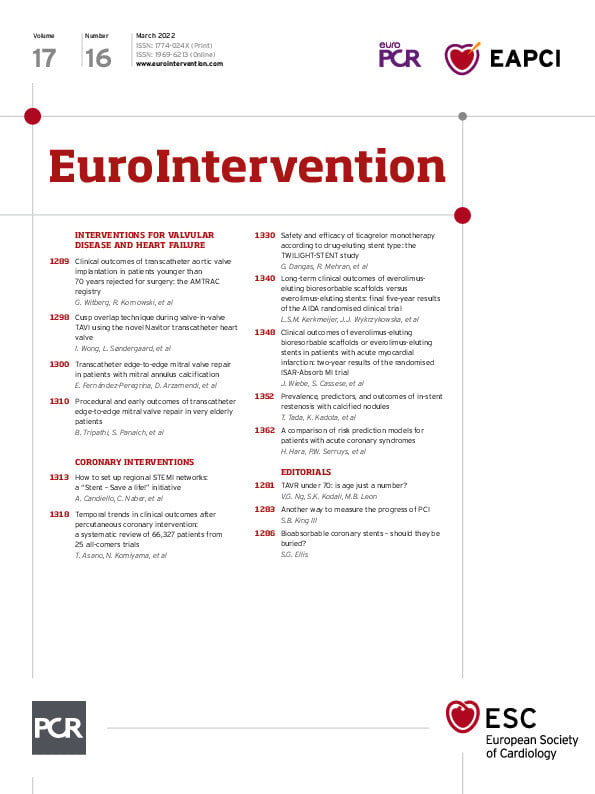For more than 50 years, the standard of care for symptomatic severe aortic stenosis (AS) has been surgical aortic valve replacement (SAVR), which has been associated with improved symptoms, prolonged survival, and few procedural complications in good surgical candidates. Although transcatheter aortic valve replacement (TAVR) was initially developed as a less invasive alternative for high or prohibitive surgical risk patients, large randomised clinical trials have clearly demonstrated TAVR parity compared with SAVR throughout the spectrum of surgical risk. Specifically, recent evidence from randomised clinical trials in low-risk patients has stimulated a change in both the U.S. and European guidelines for the management of AS12. However, since the mean age of patients in these low-risk trials was 74 years34, there is insufficient evidence to address low-risk younger patients who are appropriate surgical candidates. Additional factors must be considered when treating this presumably healthier patient population that are sometimes overlooked when treating older patients with comorbidities: valve durability; the likely need for sequential valve replacements; ease of potential future coronary access; the risk of long-term permanent pacemakers (asynchronous ventricular pacing) and mild paravalvular regurgitation. Thus, an important new controversy has arisen: what is the role of TAVR in the routine treatment of low-risk young patients (<70 years old) with a long life expectancy of at least 15 years?
In this issue of EuroIntervention, Witberg et al5 evaluate the clinical outcomes of AS patients younger than 70 years, who underwent TAVR in the AMTRAC registry. Of the 8,626 patients with TAVR between 2007-2020, they focused on the 640 (7.4%) patients who were under 70 years old (increasing from 3.9% of the total during 2007-2010 to 9.1% during 2018-2020). Although this was a younger patient population with lower Society of Thoracoic Surgeons (STS) scores, patients <70 years old in this study had significant comorbidities, including chronic obstructive lung disease, hypertension and diabetes, and had higher rates of bicuspid aortic valve disease, prior cardiac surgery, valve-in-valve procedures and alternative access procedures. While the STS score failed to categorise these patients as high risk, the Heart Teams recognised that these patients were at increased risk of surgical complications, because of extreme frailty, general anaesthesia risk, prior surgery, or comorbidities not captured in the STS score. Therefore, this study highlighted the central role of the Heart Team in identifying younger patients at increased surgical risk beyond the STS score stratification. In patients <70 years old, those identified with increased surgical risk by the Heart Team had higher post-procedural mortality than patients treated with TAVR for other reasons, independent of STS score strata, suggesting greater accuracy of the Heart Team risk profiling. These findings raise questions regarding the limitations of STS score assessments, particularly in younger patients, and emphasise the importance of a functional multidisciplinary Heart Team for clinical decision-making in all AS populations.
This study does have several limitations. We don’t know the long-term course of these younger TAVR patients, wherein bioprosthetic valve durability is an important consideration, as there are no data beyond 5 years, and most patients have less than 5-year follow-up. Also, there are unknown patient confounders in this study (such as permanent pacemakers, post-treatment haemodynamic differences, and concomitant diseases) that may impact patient outcomes. Lastly, although this study nicely demonstrates the importance of the Heart Team, the actual determination of “increased surgical risk” was ill-defined and thus, AMTRAC study methods cannot be generalised to inform or guide clinical practice.
Importantly, this study fails to address the key controversy regarding the role of TAVR in low-risk younger patients with a life expectancy beyond 15 years, since most patients in this study had significant comorbidities resulting in shorter life expectancies. The sample size of truly low-risk younger patients (largely enrolled between 2018 and 2020) was too small to draw meaningful conclusions. In this trial, the chronologically younger population was enriched with more comorbidities and complex pathophysiology, resulting perhaps in a population that was biologically older. Clearly, to address the issue of TAVR vs SAVR in low-risk younger patients with increased longevity, additional randomised trials are needed including long-term follow-up.
In the AMTRAC registry of TAVR patients <70 years old, age was just a number, as the population was biased with high-risk anatomy and/or clinical comorbidities, which became the determining factors in TAVR vs SAVR decision-making. Young patients who are deemed to have increased surgical risk by a Heart Team, but not necessarily by STS score, had similar outcomes after TAVR compared to older patients in this real-world registry. Once again, the multidisciplinary Heart Team reigned supreme in risk profiling these younger patients, and in its current iteration, the STS score may significantly underestimate surgical risk determination because comorbidities, over-represented in younger patients (such as bicuspid aortic valve disease), are not adequately expressed in the model. Thus, more than a specific age cut-off, a validated TAVR risk model is needed, that includes anatomical and clinical factors to accurately guide which younger patients would benefit from TAVR vs SAVR. Age is more than just a number and is a powerful biomarker when it serves as an inverse surrogate for life expectancy in low-risk AS patients. Importantly, age should be a consideration in the ongoing young low-risk TAVR vs SAVR debate until the long-term consequences of TAVR can be compared with SAVR in rigorous randomised clinical trials.
Conflict of interest statement
S. Kodali receives institutional research grants from Edwards, Medtronic, Boston Scientific, Abbott and JenaValve. M. Leon receives institutional clinical research grants from Abbott, Boston Scientific, Edwards, and Medtronic. V. Ng has no conflicts of interest to declare.
Supplementary data
To read the full content of this article, please download the PDF.

